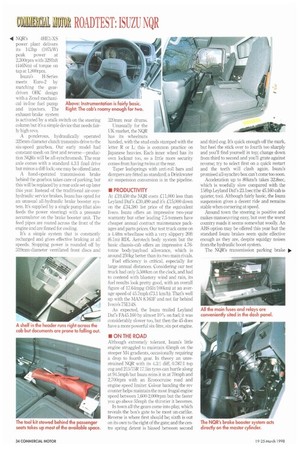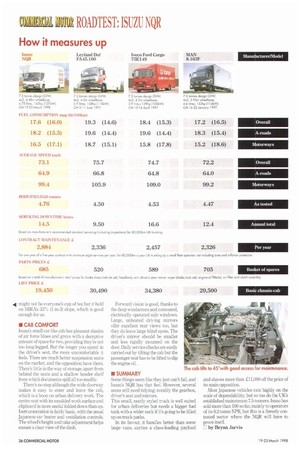alailit WI ROADTEST: ISUZU NQR
Page 34

Page 35

Page 36

Page 38

Page 37

If you've noticed an error in this article please click here to report it so we can fix it.
QUESTIONS ANSWERED
lsuzu's 6.2-tonne NPR has its admirers, but some of them have been asking for more payload. Isuzu has duly obliged with the NQR, which will be joining the fray in the hotly contested 7.5-tonne marketplace. Can this oriental contender go toe to toe with the established champs? We took one round our tough Welsh route to find out...
Invading the packed UK light truck sector is bound to be risky, but Isuzu has estab. lishecl its credibility with conservative operators by using Leyland Trucks' unique assembly and body-fitting operation, backed up by Lex Service's Transfieet and Multipart support services.
To give its latest contender the best possible chance, Isuzu developed the NQR 7.5-tonner's UK specification by talking to UK operators—as it did when launching the NQR's 3.5 and 6.2-tonne stablemates.
Now, with a basic UK design agreed, Isuzu NQRs are about to start emerging from the same Leyland Trucks plant that produces Leyland Daf's highly successful 45 and 55 Series.
Its an odd situation but the two marques are aimed at different market sectors, so while Daf might well feel twitchy about the lsuzu's £11,000 price advantage, there's no reason why East and West should get in each other's way—at least as long as the 45 continues to sell in such large numbers.
• PRODUCT PROFILE Like the lighter Isuzus, NOR kits arrive packed six to an ISO container at Leyland's assembly plant. where the 7.5-tonne chassiscabs are assembled complete with tachographs and ready for bodying.
The NOR is initially available on 1365inm, 3,815mm and 4,475mm wheelbases as a daycabbed chassis. lsuzu does build larger cabs but they're designed for smaller drivers so for UK trunking, recovery or fire-fighting duties, conversion specialists such as AutoFab, Longtons and Whitacre will step in.
The driveline is all Isuzu. from the chargecooled 4.7-litre four-pot engine to the standard rear axle. Most smaller Japanese engines give of their best at relatively high revs, but the 10. 41 NQR's 411E1-XS
power plant delivers its 143hp (107kW) peak power at 2,300rpm with 3291bft (446Nm) of torque on Lap at 1,800rpm.
Isuzu's H-Series meets Euro-2 by matching the geardriven OHC design with a Zexel mechanical in-line fuel pump and injectors. The exhaust-brake system is activated by a stalk switch on the steering column but it's a simple device that needs fairly high revs.
A ponderous, hydraulically operated 325mm-diameter clutch transmits drive to the six-speed gearbox. Our early model had constant-mesh on first and reverse—production NQRs will be all-synchromesh. The rear axle comes with a standard 4.3:1 final drive but minus a diff-lock; one may be offered later.
A hand-operated transmission brake behind the gearbox takes care of parking, but this will be replaced by a rear-axle set-up later this year. Instead of the traditional air-overhydraulic service brakes, Isuzu has opted for an unusual all-hydraulic brake booster systern. It's supplied by a single pump (that also feeds the power steering) with a pressure accumulator on the brake booster unit. The feed pipes are routed across the front of the engine and are finned for cooling.
Is a simple system that is constantly recharged and gives effective braking at all speeds. Stopping power is rounded off by 319mm-diameter ventilated front discs and 320mm rear drums.
Unusually for the UK market, the NQR has its wheelnuts handed, with the stud ends stamped with the letter R or L: this is common practice on Japanese heavies. Each inner wheel has its own locknut too, so a little more security comes from having twins at the rear.
Taper leafsprings with anti-roll bars and dampers are fitted as standard; a Drinkwater air suspension conversion is in the pipeline.
• PRODUCTIVITY At L19,450 the NQR costs £11,000 less than Leyland Daf's £30,490 and is £15,000 down on the .C34,380 list price of the equivalent Iveco. Isuzu offers an impressive two-year warranty but other leading 7.5-tonners have cheaper annual contract maintenance packages and parts prices. Our test truck came on a 4.48m wheelbase with a very slippery 20ft (6.1m) RDL Aerotech body system but the basic chassis-cab offers an impressive 4.76tonne body/payload allowance, which is around 250kg better than its two main rivals.
Fuel efficiency is critical, especially for large annual distances. Considering our test truck had only 5,500km on the clock, and had to contend with blustery wind and rain, its fuel results look pretty good, with an overall figure of 17.64mpg (161it/100km) at an average speed of 45.7mph (73.1 km/h). That's well up with the MAN 8.163F and not far behind Iveco's 75E14S.
As expected, the Isuzu trailed Leyland Daf's FA45.160 by almost 10% on fuel; it was considerably slower too, but then the 45 does have a more powerful six-litre, six-pot engine.
• ON THE ROAD
Although extremely tolerant, Isuzu's little engine struggled to maintain 65mph on the steeper M4 gradients, occasionally requiring a drop to fourth gear. In theory an unrestrained NQR with its 4.3:1 diff, 0.787:1 top cog and 215/75R 17.5in t-yres can hurtle along at 94.5mph but Isuzu reins it in at 70mph and 2,700rpm with an Econoc-ruise road and engine speed limiter. Colour banding the rev counter helps maintain the most frugal engine speed between 1,600-2,000rpm but the faster you go above 55mph the thirstier it becomes.
In town all the gears come into play, which reveals the box's gate to be most un-carlike. Reverse is where first should be; sixth is out on its own to the right of the gate; and the centre spring detent is biased between second
and third cog. It's quick enough off the mark, but heel the stick over to fourth too sharply and you'll find yourself in top; change down from third to second and you'll grate against reverse; try to select first on a quick restart and the teeth will clash again. Isuzu's promised all-synchro box can't come too soon.
Acceleration up to 80km/h takes 32.8sec, which is woefully slow compared with the 158hp Leyland Des 23.1sec (the 45.160 cab is quieter, too). Although fairly basic, the Isuzu suspension gives a decent ride and remains stable when cornering at speed.
Around town the steering is positive and makes manoeuvring easy, but over the worst country roads it seems somewhat woolly. An ABS option may be offered this year but the standard Isuzu brakes seem quite effective enough as they are, despite squidgy noises from the hydraulic boost system.
The NQR's transmission parking brake
might not be everyone's cup of tea hut it held on MIRA's 33°:.. (1-in-3) slope, which is good enough for us.
• CAB COMFORT lsuzu's small car-like cab has pleasant shades of air force blues and greys with a deceptive amount of space for two, providing they're not too long-legged. But the longer you spend in the driver's seat, the more uncomfortable it feels. There are much better suspension seats on the market, and the opposition have them. There's little in the way of storage, apart from behind the seats and a shallow header shelf from which documents spill all too readily.
There's no step although the wide doorway makes it easy to enter and leave the cab, which is a boon on urban delivery work. The centre seat with its moulded work surface and clipboard is more useful folded down than up. Instrumentation is fairly basic, with the usual Japanese car heater and ventilation controls. The wheel's height and rake adjustment helps ensure a clear view of the dash. Forward vision is good, thanks to the deep windscreen and contoured, electrically operated side windows. Large, unheated driving mirrors offer excellent rear views too, but they do leave large blind spots. The driver's mirror should be smaller and less rigidly mounted on the door. Daily service checks are easily carried out by tilting the cab but the passenger seat has to be lifted to dip the engine oil.
• SUMMARY Some things seem like they just can't fail, and Isuzu's NQR has that feel. However, several areas still need tidying; notably the gearbox, driver's seat and mirrors.
This small, neatly styled truck is well suited for urban deliveries but needs a bigger fuel tank with a wider neck if it's going to be filled up on truck parks.
In its favour, it handles better than some large vans, carries a class-leading payload
and shaves more than £11,000 off the price of its main opposition.
Most Japanese vehicles rate highly on the scale of dependability, but so too do the LIK's established mainstream 7.5-tonners. Isuzu has sold more than 100 so far, mainly to operators of its 6.2-tonne NPR, but this is a fiercely contested sector where the NQR will have to prove itself.
El by Bryan Jarvis
Price as tested: E25,034 (ex-VAT). Includes £19,450 for the basic vehicle and £5,584 for the RDL cab roof, side fairings and Aerotech body system. Engine: 4.75-litre,143hp (107kW) diesel.
GVW: 7.5 tonnes. Payload: 3,849kg. Speed: 45.7mph (73.1km/h).
Fuel consumption (laden): 16.5mpg (17.11it/ 1 00km).
SPECIFICATION
1E717111 Isuro NOR 4x2 day-cabbed rigid Design GVW: 7 5 tonnes
Imparter: isuzu Truck (UK},Thundridge Business Park, Thundrdge, Fear Ware, Harts SG12 055
IEM3rizu 4HE1-TC-S 4.75-litre direct-injection 01-IC
eno-ge-zoo ed diesel.
Cylinders: Pour, in line.
Bore/stroke: 110x125rern.
Capacity: 4.75Occ.
Compression ratio: ' 6.9:1.
Maximum Oct power: 143hp(107kW) e 2,300rpm. Maximum net torque: 329Ib11 (4415Nmil e 1.1300-2,300rpm.
TRANSMISSION_ Isuzu MBP-60 all-synchromesh six-speed manLal tsi.ecrbcx
Ratios: 6 378, 3.469, 1.963, 1.357, 1.000 and 0.787 .1; reverse, 6.595:1.
Final drive: 4 3 I .
Clutch: Diaphragm-type single dry plate, 325mm diameter
Hydrerboaster brake system with load sensing. Front. 31 Parr-diameter ventilated discs; rear. 32Ornmdiameter dr WT..5. Butterfly-valve exhaust brake; transmission park brake :drum type).
BRAKING SYSTEMS: flecirculoting.ball with integral hydraulic power ass :stoner,
IMMO Steel ladder-type Frame with pressed-steel solitaryconstruction cab.
Suspension: mdti-leat springs all round with Front onti-roll or and rear helper springs; hydraulic dampers front and rear. Axle design weights: Front, 3.1 tonnes; rear. 6.0 tonnes. Tyres: 215/75817.5 radials. Fuel tank: 100 litres.
iThiMIMEM 24V. Battery: 2el2V Alternator: 24V/5CA
TERMS OF WARRANTY Two years unlimited distorter on cFass irclucIns arlything 'itted on-line at the Leyland asse-nb y plant.
DEALERS AND SERVICE POINTS: Isuzu Trucks UK sells directly to fleet customers lion its headquarters. Lea TransPeet provides service bock-up h.-trough its 660 service outlets and independent agents. Multipart is the ports supplier.
OPERATIONAL TRIAL RESULTS Welsh test route: 367.2km (118.2km motorway/249.0km A-roads).
Overall: Average speed, 45.7mph
(73.1 km/h); Fuel consumption, 17.6mpg (16.014/100km).
Motorway: Average speed, 62.1mph (99.4km/h); fuel consumption, 16.5mpg (17.11it/100km).
A-roads: Average speed, 40.6mph (64.9km/h); fuel consumption, 18.2mpg (15.51it/100km). WEIGHTS Kerbweight (with 75kg driver) 3,651kg Net payload 3,849kg Total 7,500kg ACCELERATION km/h sec gears 0-80 32.80 — 48-80 18.60 4/5 64-96 30.45 4/5 HILL PERFORMANCE Hill min secs Monmouth Bypass 2 20 Wantage 2 00 Restart possible on 25% (1-in-4) gradient BRAKE PERFORMANCE Tests could not be carried out due to a wet track. The transmission park brake held on a 33% (1-in-3) gradient facing up and downhill.
TURNING CIRCLES Left lack 16.14m between kerbs 18.62m between walls Right lock 16,50m between kerbs 18.98m between walls
1N-CAB NOISE
km/h dB(A) Tickover 58.4 80 72.5 96 74.6 112 76.5




























































































































